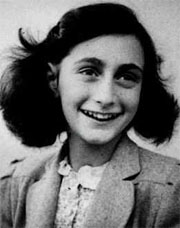
Anne Frank and her family hid from Nazi persecution of the Jews during World War II in a secret annexe above an Amsterdam warehouse. Her personal diary, a record of this experience, is one of the most widely read pieces of war literature.
On 12 June 1942, Anne Frank’s parents gave her a diary for her 13th birthday. She continued to write in her diary from 14 June 1942 until 1 August 1944. In her diary, Anne recorded her innermost feelings.
One month after receiving her diary, Anne and her family were forced to go into hiding. Amongst the few possessions they were permitted to take with them, Anne took her diary. During the next two years spent under cover, Anne’s diary became her best friend. She even gave it a name: Kitty.
Anne used pseudonyms for some of the people she describes in the diary. For instance, Fritz Pfeffer is referred to as Albert Dussel and the van Pels’ family are re-named van Daan.
On the 4th of August 1944, the eight people hiding in the secret annexe were arrested.Afterwards, Miep Gies and Bep Voskvil, the two secretaries working in the building, found Anne’s diary on the floor. After the war, once it became clear that she was dead, Miep Gies gave the diary, unread, to her father Otto Frank, the only one of the eight people to survive the war.
Otto Frank was impressed with his daughter’s diary. After long deliberation he decided to fulfill his daughter’s wish and publish it. However, Otto was unwilling to have it published in its entirety. He edited the diary into a shorter version. Together with the Dutch publishing company, Otto Frank omitted certain sections concerning Anne’s mother and certain passages concerning Anne’s developing sexuality.
After its first publication in Dutch (1947), under the title Het Achterhuis, the diary was soon translated into German and French, followed by an English edition in 1951. It then made its way onto the stage and screen. Over 50 years since its first publication, the diary has been translated into 55 languages and has sold approximately 25 million copies worldwide. Its official title in English is Anne Frank: The Diary of a Young Girl.
Neo-Nazi groups have continually targeted Anne Frank’s diary and questioned its authenticity. To establish its validity the Netherlands institute of war documentation performed test on the paper, ink and glue used in the diary, proving that it was actually written in the 1940s. Tests were also conducted on her handwriting, comparing samples from the diary with her other writings. The study concluded that Anne Frank’s diary had, in fact, been written by Anne Frank during the Holocaust years.
Once the tests had validated the diary’s authenticity, The Diary of Anne Frank: The Critical Edition was published. This includes historical backgrounds and facts surrounding Anne’s life, as well as a report on the handwriting and document analysis. This edition is often used as the scholarly, research-oriented version of the diary.
On the 50th anniversary of Anne’s death in 1995, The Diary of a Young Girl: The Definitive Edition was published. This edition contains entries that both Otto Frank and publishers in Holland had omitted from the 1947 edition. Through retrieving sections from the original diary, the 1995 edition makes readers aware of the complexities and sensitivities of Anne Frank and her struggles in her search for self-identity in the context of war and uncertainty.
Today, the diary resides in the house in Amsterdam where Anne Frank hid during the war. The house is now open to the public and sees thousands of people through its doors each year. It is known as the Anne Frank Museum.
Anne’s diary is continually read by school children everywhere. While it provides the details of Anne’s personal development, it also presents on universal themes that continue to haunt the world today.
Links
- The Anne Frank Museum
- Anne Frank House: Who Was Anne Frank?
- The Guardian: The Real Story of the Girl Behind the Diary
- History.com: Anne Frank
- Jewish Virtual Library: Anne Frank
- Biography.com: Anne Frank Biography (includes a video presentation)


